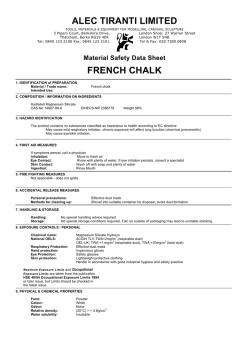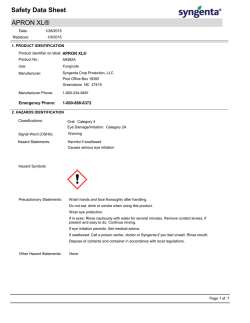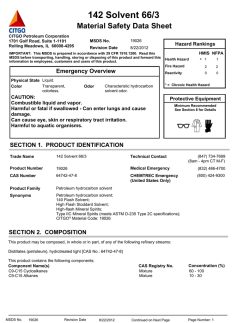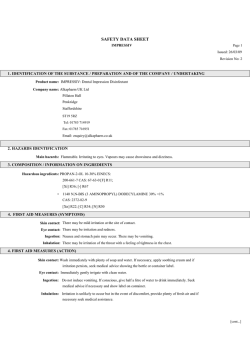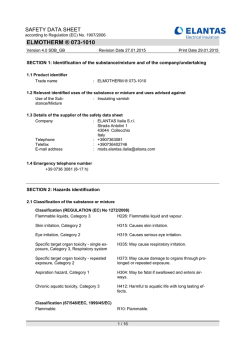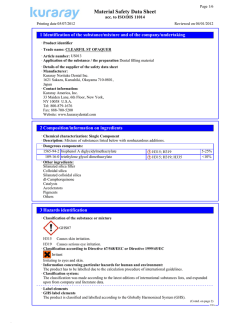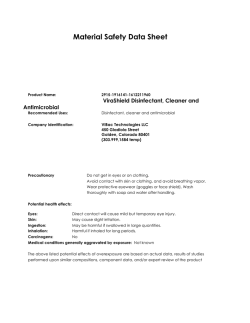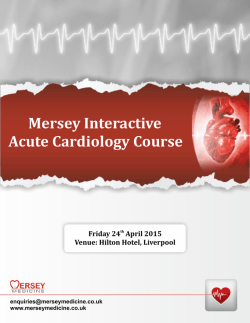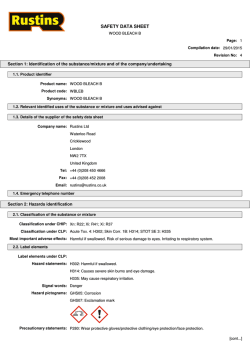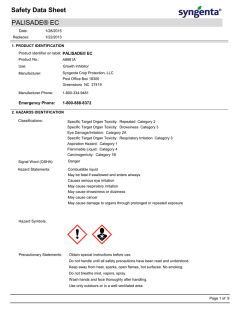
Solvent Blend 19385
SAFETY DATA SHEET Solvent Blend 19385 Section 1. Identification GHS product identifier : Solvent Blend 19385 Synonyms : Petroleum hydrocarbon solvent; CITGO® Material Code: 19385 Code : 19385 MSDS # : 19385 Supplier's details : CITGO Petroleum Corporation 1701 Golf Road, Suite 1-1101 Rolling Meadows, IL 60008-4295 [email protected] Emergency telephone number : Technical Contact: (847) 734-7630 (8am - 4pm CT M-F) Medical Emergency: (832) 486-4700 CHEMTREC Emergency: (800) 424-9300 (United States Only) Section 2. Hazards identification OSHA/HCS status Classification of the substance or mixture : This material is considered hazardous by the OSHA Hazard Communication Standard (29 CFR 1910.1200). : FLAMMABLE LIQUIDS - Category 2 ACUTE TOXICITY: INHALATION - Category 4 SKIN CORROSION/IRRITATION - Category 2 SERIOUS EYE DAMAGE/ EYE IRRITATION - Category 2B CARCINOGENICITY: INHALATION - Category 2 SPECIFIC TARGET ORGAN TOXICITY (SINGLE EXPOSURE) [Narcotic effects] Category 3 SPECIFIC TARGET ORGAN TOXICITY (REPEATED EXPOSURE): INHALATION [ears] - Category 2 ASPIRATION HAZARD - Category 1 GHS label elements Hazard pictograms : Signal word : Danger Hazard statements : Highly flammable liquid and vapor. Harmful if inhaled. Causes skin and eye irritation. Suspected of causing cancer if inhaled. May be fatal if swallowed and enters airways. May cause drowsiness and dizziness. May cause damage to organs through prolonged or repeated exposure if inhaled. (ears) Precautionary statements Prevention Date of issue/Date of revision : Obtain special instructions before use. Do not handle until all safety precautions have been read and understood. Use personal protective equipment as required. Wear protective gloves. Wear eye or face protection. Keep away from heat, sparks, open flames and hot surfaces. - No smoking. Use explosion-proof electrical, ventilating, lighting and all material-handling equipment. Use only non-sparking tools. Take precautionary measures against static discharge. Keep container tightly closed. Use only outdoors or in a well-ventilated area. Do not breathe vapor. Wash hands thoroughly after handling. : 2/25/2015. Version :1 1/14 Solvent Blend 19385 Section 2. Hazards identification Response : Get medical attention if you feel unwell. IF exposed or concerned: Get medical attention. IF INHALED: Remove victim to fresh air and keep at rest in a position comfortable for breathing. Call a POISON CENTER or physician if you feel unwell. IF SWALLOWED: Immediately call a POISON CENTER or physician. Do NOT induce vomiting. IF ON SKIN (or hair): Take off immediately all contaminated clothing. Rinse skin with water or shower. IF ON SKIN: Wash with plenty of soap and water. Take off contaminated clothing. If skin irritation occurs: Get medical attention. IF IN EYES: Rinse cautiously with water for several minutes. Remove contact lenses, if present and easy to do. Continue rinsing. If eye irritation persists: Get medical attention. : Store locked up. Store in a well-ventilated place. Keep cool. Storage Disposal Hazards not otherwise classified : Dispose of contents and container in accordance with all local, regional, national and international regulations. : None known. Section 3. Composition/information on ingredients Substance/mixture : Substance Other means of identification : Petroleum hydrocarbon solvent; CITGO® Material Code: 19385 CAS number/other identifiers CAS number : Mixture Ingredient name % CAS number C9-C15 Alkanes C9-C15 Cycloalkanes C7-C8 Cycloalkanes C7-C8 Alkanes Xylenes, mixed isomers Ethylbenzene 30 - 60 10 - 30 10 - 30 7 - 13 5 - 10 1-5 ** ** ** ** 1330-20-7 100-41-4 * = Various ** = Mixture *** = Proprietary Any concentration shown as a range is to protect confidentiality or is due to process variation. Occupational exposure limits, if available, are listed in Section 8. Section 4. First aid measures Description of necessary first aid measures Eye contact Inhalation Skin contact Date of issue/Date of revision : Immediately flush eyes with plenty of water, occasionally lifting the upper and lower eyelids. Check for and remove any contact lenses. Continue to rinse for at least 10 minutes. Get medical attention. : Remove victim to fresh air and keep at rest in a position comfortable for breathing. If it is suspected that gas or vapor is still present, the rescuer should wear an appropriate mask or self-contained breathing apparatus. If not breathing, if breathing is irregular or if respiratory arrest occurs, provide artificial respiration or oxygen by trained personnel. It may be dangerous to the person providing aid to give mouth-to-mouth resuscitation. Get medical attention. If necessary, call a poison center or physician. If unconscious, place in recovery position and get medical attention immediately. Maintain an open airway. Loosen tight clothing such as a collar, tie, belt or waistband. : Flush contaminated skin with plenty of water. Remove contaminated clothing and shoes. Continue to rinse for at least 10 minutes. Get medical attention. Wash clothing before reuse. Clean shoes thoroughly before reuse. : 2/25/2015. Version :1 2/14 Solvent Blend 19385 Section 4. First aid measures Ingestion : Get medical attention immediately. Call a poison center or physician. Wash out mouth with water. Remove dentures if any. Remove victim to fresh air and keep at rest in a position comfortable for breathing. Aspiration hazard if swallowed. Can enter lungs and cause damage. Do not induce vomiting. If vomiting occurs, the head should be kept low so that vomit does not enter the lungs. Never give anything by mouth to an unconscious person. If unconscious, place in recovery position and get medical attention immediately. Maintain an open airway. Loosen tight clothing such as a collar, tie, belt or waistband. Most important symptoms/effects, acute Potential acute health effects Eye contact : Causes eye irritation. Inhalation : Harmful if inhaled. Can cause central nervous system (CNS) depression. May cause drowsiness and dizziness. : Causes skin irritation. Skin contact Ingestion : Can cause central nervous system (CNS) depression. May be fatal if swallowed and enters airways. Irritating to mouth, throat and stomach. Over-exposure signs/symptoms Eye contact : Adverse symptoms may include the following: pain or irritation watering redness Inhalation : Adverse symptoms may include the following: nausea or vomiting headache drowsiness/fatigue dizziness/vertigo unconsciousness Skin contact : Adverse symptoms may include the following: irritation redness Ingestion : Adverse symptoms may include the following: nausea or vomiting Indication of immediate medical attention and special treatment needed, if necessary Notes to physician Specific treatments Protection of first-aiders : If ingested, this material presents a significant aspiration and chemical pneumonitis hazard. Induction of emesis is not recommended. Consider activated charcoal and/or gastric lavage. If patient is obtunded, protect the airway by cuffed endotracheal intubation or by placement of the body in a Trendelenburg and left lateral decubitus position. : Treat symptomatically and supportively. : No action shall be taken involving any personal risk or without suitable training. If it is suspected that gas or vapor is still present, the rescuer should wear an appropriate mask or self-contained breathing apparatus. It may be dangerous to the person providing aid to give mouth-to-mouth resuscitation. See toxicological information (Section 11) Section 5. Fire-fighting measures Specific hazards arising from the chemical : Highly flammable liquid and vapor. In a fire or if heated, a pressure increase will occur and the container may burst, with the risk of a subsequent explosion. The vapor/gas is heavier than air and will spread along the ground. Vapors may accumulate in low or confined areas or travel a considerable distance to a source of ignition and flash back. Runoff to sewer may create fire or explosion hazard. Extinguishing media Date of issue/Date of revision : 2/25/2015. Version :1 3/14 Solvent Blend 19385 Section 5. Fire-fighting measures Suitable extinguishing media : Use dry chemical, CO₂, water spray (fog) or foam. Unsuitable extinguishing media : Do not use water jet. Hazardous thermal decomposition products : Decomposition products may include the following materials: carbon dioxide carbon monoxide Special protective actions for fire-fighters Special protective equipment for fire-fighters : Promptly isolate the scene by removing all persons from the vicinity of the incident if there is a fire. No action shall be taken involving any personal risk or without suitable training. Move containers from fire area if this can be done without risk. Use water spray to keep fire-exposed containers cool. : Fire-fighters should wear appropriate protective equipment and self-contained breathing apparatus (SCBA) with a full face-piece operated in positive pressure mode. Section 6. Accidental release measures Personal precautions, protective equipment and emergency procedures For non-emergency personnel : No action shall be taken involving any personal risk or without suitable training. Evacuate surrounding areas. Keep unnecessary and unprotected personnel from entering. Do not touch or walk through spilled material. Shut off all ignition sources. No flares, smoking or flames in hazard area. Avoid breathing vapor or mist. Provide adequate ventilation. Wear appropriate respirator when ventilation is inadequate. Put on appropriate personal protective equipment. For emergency responders : If specialized clothing is required to deal with the spillage, take note of any information in Section 8 on suitable and unsuitable materials. See also the information in "For nonemergency personnel". Environmental precautions : Avoid dispersal of spilled material and runoff and contact with soil, waterways, drains and sewers. Inform the relevant authorities if the product has caused environmental pollution (sewers, waterways, soil or air). Methods and materials for containment and cleaning up Small spill Large spill : Stop leak if without risk. Move containers from spill area. Use spark-proof tools and explosion-proof equipment. Dilute with water and mop up if water-soluble. Alternatively, or if water-insoluble, absorb with an inert dry material and place in an appropriate waste disposal container. Dispose of via a licensed waste disposal contractor. : Stop leak if without risk. Move containers from spill area. Use spark-proof tools and explosion-proof equipment. Approach release from upwind. Prevent entry into sewers, water courses, basements or confined areas. Wash spillages into an effluent treatment plant or proceed as follows. Contain and collect spillage with non-combustible, absorbent material e.g. sand, earth, vermiculite or diatomaceous earth and place in container for disposal according to local regulations (see Section 13). Dispose of via a licensed waste disposal contractor. Contaminated absorbent material may pose the same hazard as the spilled product. Note: see Section 1 for emergency contact information and Section 13 for waste disposal. Section 7. Handling and storage Precautions for safe handling Protective measures Date of issue/Date of revision : Put on appropriate personal protective equipment (see Section 8). Avoid exposure obtain special instructions before use. Do not handle until all safety precautions have been read and understood. Do not get in eyes or on skin or clothing. Do not breathe vapor or mist. Do not swallow. Use only with adequate ventilation. Wear appropriate respirator when ventilation is inadequate. Do not enter storage areas and confined spaces unless adequately ventilated. Keep in the original container or an approved alternative made from a compatible material, kept tightly closed when not in use. Store and use away from heat, sparks, open flame or any other ignition source. Use explosion-proof electrical (ventilating, lighting and material handling) equipment. Use only non-sparking tools. Take precautionary measures against electrostatic discharges. : 2/25/2015. Version :1 4/14 Solvent Blend 19385 Section 7. Handling and storage Advice on general occupational hygiene Conditions for safe storage, including any incompatibilities Empty containers retain product residue and can be hazardous. Do not reuse container. Non equilibrium conditions may increase the fire hazard associated with this product. Always bond receiving containers to the fill pipe before and during loading. Always confirm that receiving container is properly grounded. Bonding and grounding alone may be inadequate to eliminate fire and explosion hazards. Carefully review operations that may increase the risks such as tank and container filling, tank cleaning, sampling, gauging, loading, filtering, mixing, agitation, etc. In addition to bonding and grounding, efforts to mitigate the hazards may include, but are not limited to, ventilation, inerting and/or reduction of transfer velocities. Always keep nozzle in contact with the container throughout the loading process. Do NOT fill any portable container in or on a vehicle. : Eating, drinking and smoking should be prohibited in areas where this material is handled, stored and processed. Workers should wash hands and face before eating, drinking and smoking. Remove contaminated clothing and protective equipment before entering eating areas. See also Section 8 for additional information on hygiene measures. : Store in accordance with local regulations. Store in a segregated and approved area. Store in original container protected from direct sunlight in a dry, cool and well-ventilated area, away from incompatible materials (see Section 10) and food and drink. Store locked up. Eliminate all ignition sources. Separate from oxidizing materials. Keep container tightly closed and sealed until ready for use. Containers that have been opened must be carefully resealed and kept upright to prevent leakage. Do not store in unlabeled containers. Use appropriate containment to avoid environmental contamination. Bulk Storage Conditions: Maintain all storage tanks in accordance with applicable regulations. Use necessary controls to monitor tank inventories. Inspect all storage tanks on a periodic basis. Test tanks and associated piping for tightness. Maintain the automatic leak detection devices to assure proper working condition. Section 8. Exposure controls/personal protection Control parameters Occupational exposure limits Ingredient name Exposure limits C9-C15 Cycloalkanes ACGIH TLV (United States). TWA: 400 ppm 8 hours. Form: Methylcyclohexane ACGIH TLV (United States). TWA: 1500 mg/m³ ACGIH TLV (United States, 4/2014). TWA: 100 ppm 8 hours. TWA: 434 mg/m³ 8 hours. STEL: 150 ppm 15 minutes. STEL: 651 mg/m³ 15 minutes. OSHA PEL (United States, 2/2013). TWA: 100 ppm 8 hours. TWA: 435 mg/m³ 8 hours. ACGIH TLV (United States, 4/2014). TWA: 20 ppm 8 hours. OSHA PEL (United States, 2/2013). TWA: 100 ppm 8 hours. TWA: 435 mg/m³ 8 hours. C7-C8 Alkanes Xylenes, mixed isomers Ethylbenzene Solvent Blend 19385 Date of issue/Date of revision ACGIH TLV (United States) 249 ppm (1200 mg/m³) 8 hour(s) Notes: The TLV for the hydrocarbon solvent is based on the procedure described in Appendix H ("Reciprocal Calculations Method for Certain Refined Hydrocarbon Solvent Vapors") of the ACGIH TLVs ® and BEIs® guidelines. The GGVmixture (ACGIH TLV) is based on Column B (McKee et al., 2005) of Table 1 ("Group : 2/25/2015. Version :1 5/14 Solvent Blend 19385 Section 8. Exposure controls/personal protection Guidance Values") of Appendix H. Appropriate engineering controls Environmental exposure controls : Use only with adequate ventilation. Use process enclosures, local exhaust ventilation or other engineering controls to keep worker exposure to airborne contaminants below any recommended or statutory limits. The engineering controls also need to keep gas, vapor or dust concentrations below any lower explosive limits. Use explosion-proof ventilation equipment. : Emissions from ventilation or work process equipment should be checked to ensure they comply with the requirements of environmental protection legislation. In some cases, vapor controls, filters or engineering modifications to the process equipment will be necessary to reduce emissions to acceptable levels. Individual protection measures Hygiene measures Eye/face protection : Wash hands, forearms and face thoroughly after handling chemical products, before eating, smoking and using the lavatory and at the end of the working period. Appropriate techniques should be used to remove potentially contaminated clothing. Wash contaminated clothing before reusing. Ensure that eyewash stations and safety showers are close to the workstation location. : Safety glasses equipped with side shields are recommended as minimum protection in industrial settings. If contact is possible, the following protection should be worn, unless the assessment indicates a higher degree of protection: Splash goggles. Safety eyewear complying with an approved standard should be used when a risk assessment indicates this is necessary to avoid exposure to liquid splashes, mists, gases or dusts. chemical splash goggles. If inhalation hazards exist, a full-face respirator may be required instead. Skin protection Hand protection Body protection Other skin protection Respiratory protection : Chemical-resistant gloves complying with an approved standard should be worn at all times when handling chemical products if a risk assessment indicates this is necessary. Considering the parameters specified by the glove manufacturer, check during use that the gloves are still retaining their protective properties. It should be noted that the time to breakthrough for any glove material may be different for different glove manufacturers. : Personal protective equipment for the body should be selected based on the task being performed and the risks involved and should be approved by a specialist before handling this product. : Appropriate footwear and any additional skin protection measures should be selected based on the task being performed and the risks involved and should be approved by a specialist before handling this product. : Use a properly fitted, air-purifying or supplied-air respirator complying with an approved standard if a risk assessment indicates this is necessary. Respirator selection must be based on known or anticipated exposure levels, the hazards of the product and the safe working limits of the selected respirator. Section 9. Physical and chemical properties Physical state : Liquid. Color : Transparent, colorless. Odor pH Boiling point/boiling range : Characteristic hydrocarbon solvent odor. : Not available. : 130 to 144°C (266 to 291.2°F) Flash point : Closed cup: 21°C (69.8°F) [Tagliabue.] Evaporation rate : 1 (n-butyl acetate. = 1) Lower and upper explosive (flammable) limits : Not available. Vapor pressure : 0.67 kPa (5 mm Hg) [room temperature] Vapor density : 4 [Air = 1] : 0.77 Relative density Date of issue/Date of revision : 2/25/2015. Version :1 6/14 Solvent Blend 19385 Section 9. Physical and chemical properties Density lbs/gal : Estimated 6.42 lbs/gal Gravity, °API Solubility : Estimated 52 @ 60 F : Very slightly soluble in the following materials: cold water. Conductivity : <5 picosiemens/meter (unadditized) Section 10. Stability and reactivity Reactivity : Not expected to be Explosive, Self-Reactive, Self-Heating, or an Organic Peroxide under US GHS Definition(s). Chemical stability : The product is stable. Possibility of hazardous reactions : Under normal conditions of storage and use, hazardous reactions will not occur. Conditions to avoid : Avoid all possible sources of ignition (spark or flame). Do not pressurize, cut, weld, braze, solder, drill, grind or expose containers to heat or sources of ignition. Do not allow vapor to accumulate in low or confined areas. Incompatible materials : Reactive or incompatible with the following materials: oxidizing materials Hazardous decomposition products : Under normal conditions of storage and use, hazardous decomposition products should not be produced. Section 11. Toxicological information Information on toxicological effects Acute toxicity Product/ingredient name Result Species Xylenes, mixed isomers LC50 Inhalation Gas. LC50 Inhalation Gas. LC50 Inhalation Gas. LC50 Inhalation Gas. LD50 Oral LD50 Oral LD50 Oral LD50 Dermal LD50 Oral Cat Rat Rat Rat Mouse Rat Rat Rabbit Rat Ethylbenzene Conclusion/Summary Dose Exposure 9500 ppm 5000 ppm 6700 ppm 6670 ppm 2119 mg/kg 4300 mg/kg 4300 mg/kg >5000 mg/kg 3500 mg/kg 2 hours 4 hours 4 hours 4 hours - : C9-C15 Alkanes: In animal studies utilizing mineral spirits containing up to 22% aromatics indicated that the acute central nervous system effects are reversible. Based on existing animal studies, the potential for persistent effects is not clear. Xylenes, mixed isomers: Effects from Acute Exposure: ORAL (LD50), Acute: 4,300 mg/kg [Rat]. INHALATION (LC50), Acute: 4,550 ppm for four hours [Rat]. DERMAL (LD50), Acute: 14,100 uL/kg [Rabbit]. Overexposure to xylene may cause upper respiratory tract irritation, headache, cyanosis, blood serum changes, CNS damage and narcosis. Effects may be increased by the use of alcoholic beverages. Evidence of liver and kidney impairment were reported in workers recovering from a gross over-exposure. Ethylbenzene: Effects from Acute Exposure: ORAL (LD50), Acute: 3,500 mg/kg [Rat]. DERMAL (LD50), Acute: 17,800 uL/kg [Rabbit]. INTRAPERITONEAL (LD50), Acute: 2,624 mg/kg [Rat]. Effects from Prolonged or Repeated Exposure: Findings from a 2-year inhalation study in rodents conducted by NTP were as follows: Effects were observed only at the highest exposure level (750 ppm). At this level the Date of issue/Date of revision : 2/25/2015. Version :1 7/14 Solvent Blend 19385 Section 11. Toxicological information incidence of renal tumors was elevated in male rats (tubular carcinomas) and female rats (tubular adenomas). Also, the incidence of tumors was elevated in male mice (alveolar and bronchiolar carcinomas) and female mice (hepatocellular carcinomas). IARC has classified ethyl benzene as “possibly carcinogenic to humans” (Group 2B). Studies in laboratory animals indicate some evidence of post-implantation deaths following high levels of maternal exposure. The relevance of these findings to humans is not clear at this time. Studies in laboratory animals indicate limited evidence of renal malformations, resorptions, and developmental delays following high levels of maternal exposure. The relevance of these findings to humans is not clear at this time. Studies in laboratory animals indicate some evidence of adverse effects on the liver, kidney, thyroid, and pituitary gland. Irritation/Corrosion Product/ingredient name Result Species Score Exposure Observation Xylenes, mixed isomers Skin - Mild irritant Rat - - Skin - Moderate irritant Rabbit - Skin - Moderate irritant Skin - Mild irritant Rabbit Rabbit - 8 hours 60 microliters 24 hours 500 milligrams 100 Percent 24 hours 15 milligrams Ethylbenzene Skin Eyes Respiratory - : C9-C15 Alkanes: Primary dermal irritation studies (four hour exposure) in rabbits utilizing mineral spirits containing less than 2% aromatics resulted in slight to moderate skin irritation. In humans, mineral spirits have produced slight to moderate skin irritation particularly with evaporation from the skin is prevented. : Xylenes, mixed isomers: When splashed in the eyes, xylene may cause burning pain, conjuctivitis, corneal vacuolation, and keratitis. : C9-C15 Alkanes: Animal studies have demonstrated that mineral spirits produced mild respiratory tract irritation at elevated concentrations. Also, sensory respiratory tract irritation was evident by reduced breathing rates in the test animals in certain studies. Sensitization Skin Respiratory Mutagenicity Conclusion/Summary Carcinogenicity Conclusion/Summary : C9-C15 Alkanes: In animal studies utilizing mineral spirits containing up to 18%, aromatics skin sensitization is not evident. : No additional information. : C9-C15 Alkanes: In vivo and in vitro studies on mineral spirits containing up to 22 % aromatics indicate that these products are not genotoxic. : C9-C15 Alkanes: The National Toxicology Program (NTP) conducted two-year carcinogenicity studies in rats and mice with Stoddard Solvent IIC (less than 2% aromatics). The studies indicated that there was some evidence of carcinogenic activity in male rats (adrenal medulla neoplasms and renal tubule adenoma) but no evidence of carcinogenic activity in female rats. Further, there was equivocal evidence of carcinogenic activity in female mice (hepatocellular adenoma) but no evidence of carcinogenic activity in male mice. A low carcinogenic potential is suggested by a lack of genotoxic potential identified in in vivo and in vitro genetic toxicity tests (with and without metabolic activation). Classification Product/ingredient name OSHA IARC NTP Xylenes, mixed isomers Ethylbenzene - 3 2B - Reproductive toxicity Conclusion/Summary Teratogenicity Conclusion/Summary Date of issue/Date of revision : C9-C15 Alkanes: There were no treatment-related effects on pregnancy rate, mortality or gross post mortem observations in animal studies utilizing mineral spirits containing less than 2% aromatics. : : 2/25/2015. Version :1 8/14 Solvent Blend 19385 Section 11. Toxicological information C9-C15 Alkanes: There were no treatment-related effects on pregnancy rate, mortality or gross post mortem observations in animal studies utilizing mineral spirits containing less than 2% aromatics. Specific target organ toxicity (single exposure) Name Category Route of exposure Target organs C9-C15 Alkanes C9-C15 Cycloalkanes C7-C8 Cycloalkanes C7-C8 Alkanes Ethylbenzene Category 3 Category 3 Category 3 Category 3 Category 3 Not applicable. Not applicable. Not applicable. Not applicable. Not applicable. Narcotic effects Narcotic effects Narcotic effects Narcotic effects Respiratory tract irritation Name Category Route of exposure Target organs Ethylbenzene Category 2 Inhalation ears Specific target organ toxicity (repeated exposure) Aspiration hazard Name Result C9-C15 Alkanes C9-C15 Cycloalkanes C7-C8 Cycloalkanes C7-C8 Alkanes Ethylbenzene ASPIRATION HAZARD - Category 1 ASPIRATION HAZARD - Category 1 ASPIRATION HAZARD - Category 1 ASPIRATION HAZARD - Category 1 ASPIRATION HAZARD - Category 1 Information on the likely routes of exposure : Routes of entry anticipated: Oral, Dermal, Inhalation. Potential acute health effects Eye contact : Causes eye irritation. Inhalation Skin contact Ingestion : Harmful if inhaled. Can cause central nervous system (CNS) depression. May cause drowsiness and dizziness. : Causes skin irritation. : Can cause central nervous system (CNS) depression. May be fatal if swallowed and enters airways. Irritating to mouth, throat and stomach. Symptoms related to the physical, chemical and toxicological characteristics Eye contact : Adverse symptoms may include the following: pain or irritation watering redness Inhalation : Adverse symptoms may include the following: nausea or vomiting headache drowsiness/fatigue dizziness/vertigo unconsciousness Skin contact : Adverse symptoms may include the following: irritation redness Ingestion : Adverse symptoms may include the following: nausea or vomiting Potential chronic health effects General : May cause damage to organs through prolonged or repeated exposure if inhaled. Date of issue/Date of revision : 2/25/2015. Version :1 9/14 Solvent Blend 19385 Section 11. Toxicological information Carcinogenicity Mutagenicity : Suspected of causing cancer if inhaled. Risk of cancer depends on duration and level of exposure. : No known significant effects or critical hazards. Teratogenicity : No known significant effects or critical hazards. Developmental effects : No known significant effects or critical hazards. Fertility effects : No known significant effects or critical hazards. Section 12. Ecological information Toxicity Product/ingredient name Result Species Exposure Xylenes, mixed isomers Acute EC50 90 mg/l Fresh water Acute LC50 8.5 ppm Marine water Crustaceans - Cypris subglobosa Crustaceans - Palaemonetes pugio - Adult Crustaceans - Palaemonetes pugio Fish - Lepomis macrochirus Juvenile (Fledgling, Hatchling, Weanling) Fish - Lepomis macrochirus Fish - Pimephales promelas Fish - Carassius auratus Algae - Pseudokirchneriella subcapitata Algae - Pseudokirchneriella subcapitata Daphnia - Daphnia magna Neonate Crustaceans - Americamysis bahia Fish - Oncorhynchus mykiss Algae - Pseudokirchneriella subcapitata 48 hours 48 hours Acute LC50 8500 µg/l Marine water Acute LC50 15700 µg/l Fresh water Ethylbenzene Acute LC50 19000 µg/l Fresh water Acute LC50 13400 µg/l Fresh water Acute LC50 16940 µg/l Fresh water Acute EC50 4600 µg/l Fresh water Acute EC50 3600 µg/l Fresh water Acute EC50 2930 µg/l Fresh water Acute LC50 5200 µg/l Marine water Acute LC50 4200 µg/l Fresh water Chronic NOEC 1000 µg/l Fresh water Conclusion/Summary 48 hours 96 hours 96 hours 96 hours 96 hours 72 hours 96 hours 48 hours 48 hours 96 hours 96 hours : Not available. Persistence and degradability Not available. Conclusion/Summary : Not available. Bioaccumulative potential Product/ingredient name LogPow BCF Potential Xylenes, mixed isomers Ethylbenzene 3.12 3.6 8.1 to 25.9 - low low Mobility in soil Soil/water partition coefficient (KOC) Other adverse effects Date of issue/Date of revision : Not available. : No known significant effects or critical hazards. : 2/25/2015. Version :1 10/14 Solvent Blend 19385 Section 13. Disposal considerations Disposal methods : The generation of waste should be avoided or minimized wherever possible. Disposal of this product, solutions and any by-products should at all times comply with the requirements of environmental protection and waste disposal legislation and any regional local authority requirements. Dispose of surplus and non-recyclable products via a licensed waste disposal contractor. Waste should not be disposed of untreated to the sewer unless fully compliant with the requirements of all authorities with jurisdiction. Waste packaging should be recycled. This material and its container must be disposed of in a safe way. Care should be taken when handling emptied containers that have not been cleaned or rinsed out. Empty containers or liners may retain some product residues. Vapor from product residues may create a highly flammable or explosive atmosphere inside the container. Do not cut, weld or grind used containers unless they have been cleaned thoroughly internally. Avoid dispersal of spilled material and runoff and contact with soil, waterways, drains and sewers. : D001, D018 RCRA classification United States - RCRA Toxic hazardous waste "U" List Ingredient CAS # Status Reference number Xylenes, mixed isomers 1330-20-7 Listed U239 Section 14. Transport information DOT Classification IMDG UN1268 IATA UN number UN 1268 UN1268 UN proper shipping name UN1268, Petroleum Distillates, n. PETROLEUM DISTILLATES, N. PETROLEUM DISTILLATES, N. o.s. (Naphtha Solvent, Xylene), O.S. (Naphtha Solvent, Xylene), O.S. (Naphtha Solvent, Xylene), 3, PG II RQ solution 3, PG II 3, PG II Transport 3 hazard class(es) 3 3 Packing group II II II Environmental hazards No. No. No. Additional information Reportable quantity 1556.3 lbs / 706.58 kg [242.41 gal / 917.63 L] Package sizes shipped in quantities less than the product reportable quantity are not subject to the RQ (reportable quantity) transportation requirements. - - Special precautions for user : Transport within user’s premises: always transport in closed containers that are upright and secure. Ensure that persons transporting the product know what to do in the event of an accident or spillage. Date of issue/Date of revision : 2/25/2015. Version :1 11/14 Solvent Blend 19385 Section 15. Regulatory information U.S. Federal regulations : United States inventory (TSCA 8b): All components are listed or exempted. Clean Water Act (CWA) 307: Toluene; Ethylbenzene; Benzene; Naphthalene Clean Water Act (CWA) 311: Toluene; Xylenes, mixed isomers; Ethylbenzene; Benzene; Naphthalene; Xylene This material is classified as an oil under Section 311 of the Clean Water Act (CWA) and the Oil Pollution Act of 1990 (OPA). Discharges or spills which produce a visible sheen on waters of the United States, their adjoining shorelines, or into conduits leading to surface waters must be reported to the EPA's National Response Center at (800) 424-8802. SARA 302/304 Composition/information on ingredients SARA 304 RQ : Not applicable. SARA 311/312 Classification : Fire hazard Immediate (acute) health hazard Delayed (chronic) health hazard Composition/information on ingredients Name Fire Sudden hazard release of pressure Reactive Immediate (acute) health hazard Delayed (chronic) health hazard C9-C15 Alkanes C9-C15 Cycloalkanes C7-C8 Cycloalkanes C7-C8 Alkanes Xylenes, mixed isomers Ethylbenzene Yes. Yes. Yes. Yes. Yes. Yes. No. No. No. No. No. No. Yes. Yes. Yes. Yes. Yes. Yes. No. No. No. No. Yes. Yes. No. No. No. No. No. No. SARA 313 Product name CAS number % Form R - Reporting requirements Xylenes, mixed isomers Ethylbenzene 1330-20-7 100-41-4 <10 <2 Supplier notification Xylenes, mixed isomers Ethylbenzene 1330-20-7 100-41-4 <10 <2 SARA 313 notifications must not be detached from the SDS and any copying and redistribution of the SDS shall include copying and redistribution of the notice attached to copies of the SDS subsequently redistributed. State regulations Massachusetts : The following components are listed: Xylenes, mixed isomers; Ethylbenzene; XYLENE New York : The following components are listed: Ethylbenzene; Xylene (mixed) New Jersey : The following components are listed: Xylenes, mixed isomers; Ethylbenzene; XYLENES; BENZENE, DIMETHYL: The following components are listed: Xylenes, mixed isomers; Ethylbenzene; BENZENE, DIMETHYL- Pennsylvania California Prop. 65 WARNING: This product contains a chemical known to the State of California to cause cancer. WARNING: This product contains less than 1% of a chemical known to the State of California to cause birth defects or other reproductive harm. Date of issue/Date of revision : 2/25/2015. Version :1 12/14 Solvent Blend 19385 Section 15. Regulatory information % Ingredient name Cancer Reproductive No significant risk level 41 µg/day (ingestion) No. 54 µg/day (inhalation) No. 7000 µg/day (ingestion) No. No. 6.4 µg/day 24 µg/day (ingestion) (ingestion) 49 µg/day 13 µg/day (inhalation) (inhalation) Yes. No. Ethylbenzene <2 Yes. No. Toluene <0.1 No. Yes. Cumene Benzene <0.1 <0.01 Yes. Yes. No. Yes. Naphthalene <0.01 Yes. No. Maximum acceptable dosage level International regulations International lists : Australia inventory (AICS): All components are listed or exempted. China inventory (IECSC): All components are listed or exempted. Japan inventory: All components are listed or exempted. Korea inventory: All components are listed or exempted. Malaysia Inventory (EHS Register): All components are listed or exempted. New Zealand Inventory of Chemicals (NZIoC): All components are listed or exempted. Philippines inventory (PICCS): All components are listed or exempted. Taiwan inventory (CSNN): All components are listed or exempted. : All components are listed or exempted. : All components are listed or exempted. Canada inventory EU Inventory WHMIS (Canada) : Class B-2: Flammable liquid Class D-2A: Material causing other toxic effects (Very toxic). Class D-2B: Material causing other toxic effects (Toxic). Section 16. Other information National Fire Protection Association (U.S.A.) Flammability 3 Health 1 0 Instability/Reactivity Special Reprinted with permission from NFPA 704-2001, Identification of the Hazards of Materials for Emergency Response Copyright ©1997, National Fire Protection Association, Quincy, MA 02269. This reprinted material is not the complete and official position of the National Fire Protection Association, on the referenced subject which is represented only by the standard in its entirety. Copyright ©2001, National Fire Protection Association, Quincy, MA 02269. This warning system is intended to be interpreted and applied only by properly trained individuals to identify fire, health and reactivity hazards of chemicals. The user is referred to certain limited number of chemicals with recommended classifications in NFPA 49 and NFPA 325, which would be used as a guideline only. Whether the chemicals are classified by NFPA or not, anyone using the 704 systems to classify chemicals does so at their own risk. History Date of issue/Date of revision Key to abbreviations Date of issue/Date of revision : 2/25/2015. : ATE = Acute Toxicity Estimate BCF = Bioconcentration Factor GHS = Globally Harmonized System of Classification and Labelling of Chemicals IATA = International Air Transport Association IBC = Intermediate Bulk Container IMDG = International Maritime Dangerous Goods LogPow = logarithm of the octanol/water partition coefficient MARPOL 73/78 = International Convention for the Prevention of Pollution From Ships, : 2/25/2015. Version :1 13/14 Solvent Blend 19385 Section 16. Other information 1973 as modified by the Protocol of 1978. ("Marpol" = marine pollution) UN = United Nations Notice to reader THE INFORMATION IN THIS SAFETY DATA SHEET (SDS) WAS OBTAINED FROM SOURCES WHICH WE BELIEVE ARE RELIABLE. HOWEVER, THE INFORMATION IS PROVIDED WITHOUT ANY WARRANTY, EXPRESSED OR IMPLIED REGARDING ITS CORRECTNESS OR ACCURACY. SOME INFORMATION PRESENTED AND CONCLUSIONS DRAWN HEREIN ARE FROM SOURCES OTHER THAN DIRECT TEST DATA ON THE SUBSTANCE ITSELF. THIS SDS WAS PREPARED AND IS TO BE USED ONLY FOR THIS PRODUCT. IF THE PRODUCT IS USED AS A COMPONENT IN ANOTHER PRODUCT, THIS SDS INFORMATION MAY NOT BE APPLICABLE. USERS SHOULD MAKE THEIR OWN INVESTIGATIONS TO DETERMINE THE SUITABILITY OF THE INFORMATION OR PRODUCTS FOR THEIR PARTICULAR PURPOSE OR APPLICATION. THE CONDITIONS OR METHODS OF HANDLING, STORAGE, USE, AND/OR DISPOSAL OF THE PRODUCT ARE BEYOND OUR CONTROL AND MAY BE BEYOND OUR KNOWLEDGE. FOR THIS AND OTHER REASONS, WE DO NOT ASSUME RESPONSIBILITY AND EXPRESSLY DISCLAIM LIABILITY FOR ANY LOSS, DAMAGE OR EXPENSE ARISING OUT OF OR IN ANY WAY CONNECTED WITH HANDLING, STORAGE, USE OR DISPOSAL OF THE PRODUCT. CITGO is a registered trademark of CITGO Petroleum Corporation Date of issue/Date of revision : 2/25/2015. Version :1 14/14
© Copyright 2025
